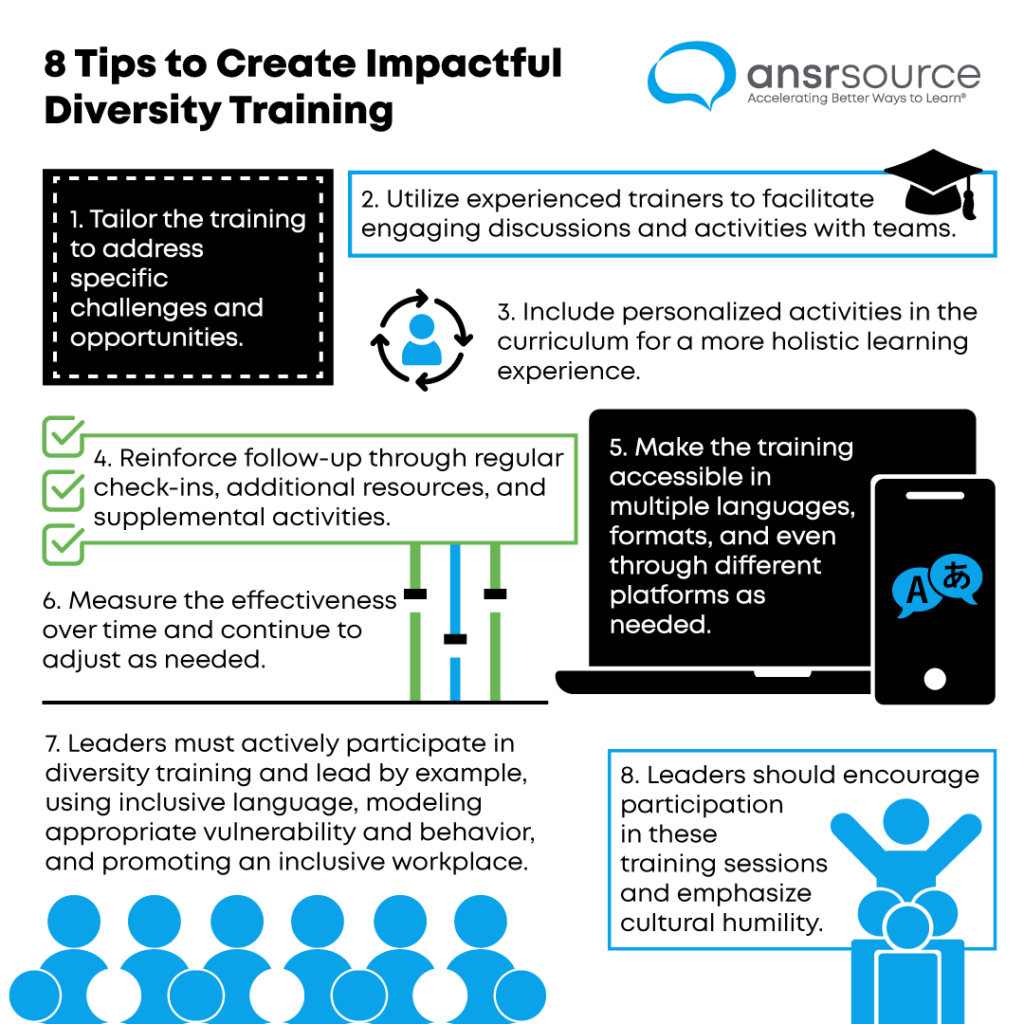By now, organizational leaders should understand that investing in diversity, equity, inclusion, and belonging are sound business practices. Research shows that a company’s commitment to diversity improves recruitment and retention, enhances employee engagement and satisfaction, and increases productivity.
One way for companies to establish a commitment to diversity is through a strategically planned diversity training series. There are several factors to consider in planning diversity training that will ensure its success.

Here are the 8 suggestions for creating impactful diversity training:
- Tailor the training: Every organization is different; every team is different. Effective training should be designed to address the specific challenges and opportunities that the organization or team is facing.
- Utilize experienced trainers: The trainers need to be skilled, knowledgeable, and have the experience required to effectively deliver the training and to facilitate engaging discussions and activities with teams.
- Provide engaging and personalized activities: Employees who can personalize the material and apply what they learn in practical ways will be more likely to retain the information that is shared. Employees should be given opportunities to share their own experiences and perspectives.
- Reinforce follow-up: For a one-time diversity training to be truly effective, leaders need to use regular check-ins, share additional resources, provide opportunities for further training and development, and incorporate supplemental activities that reinforce the training objectives.
- Measure the effectiveness: Not only should leaders measure the immediate response to the training to understand the impact, but leaders should also track the progress and effectiveness of the diversity training program over time and continue to adjust as needed.
- Make the training accessible: Depending on the team’s needs, training may need to be offered in multiple languages, accessible in various formats (online, in-person, as self-paced tutorials, audio only, visual only, and so on), and accessible at different times depending on time zones.
- Lead by example: Leaders must actively participate in diversity training and lead by example, using inclusive language, modeling appropriate vulnerability and behavior, and promoting an inclusive workplace so employees feel that they belong.
- Set the training up for success: Leaders should encourage participation in these training sessions and emphasize cultural humility, so employees approach the sessions with an open mind, a non-judgmental attitude, and a sense of curiosity to learn about different cultures, backgrounds, and perspectives.
There are a few barriers leaders should be aware of that have the potential to impact the effectiveness of diversity training. Four of those barriers are outlined below.
- Mandatory training: Requiring employees to attend diversity trainings can create a pressure cooker. Employees should approach diversity training with a sense of cultural humility, and making the training a requirement for someone who is not interested in attending can be challenging.
- Psychological safety: For participants to feel open to share their thoughts and truly engage with the material, they must feel psychosocially safe to participate. If a team member’s supervisor or a company leader is present in the training, this has the potential to stifle engagement.
- Commitment: Leaders across the organization must all be committed to embarking on this endeavor and must embrace the strategic plan for improving diversity. If one leader is more committed than another leader, the teams will experience different levels of commitment, and this disparity will have an impact.
- Resources: The leadership team must be ready to dedicate appropriate time and financial support to ensure success.
Now that you know how to ensure the success with your DEI training initiatives, it’s time to get started. ansrsource has a team of experts ready to help you with your DEI training journey—reach out to us today!



